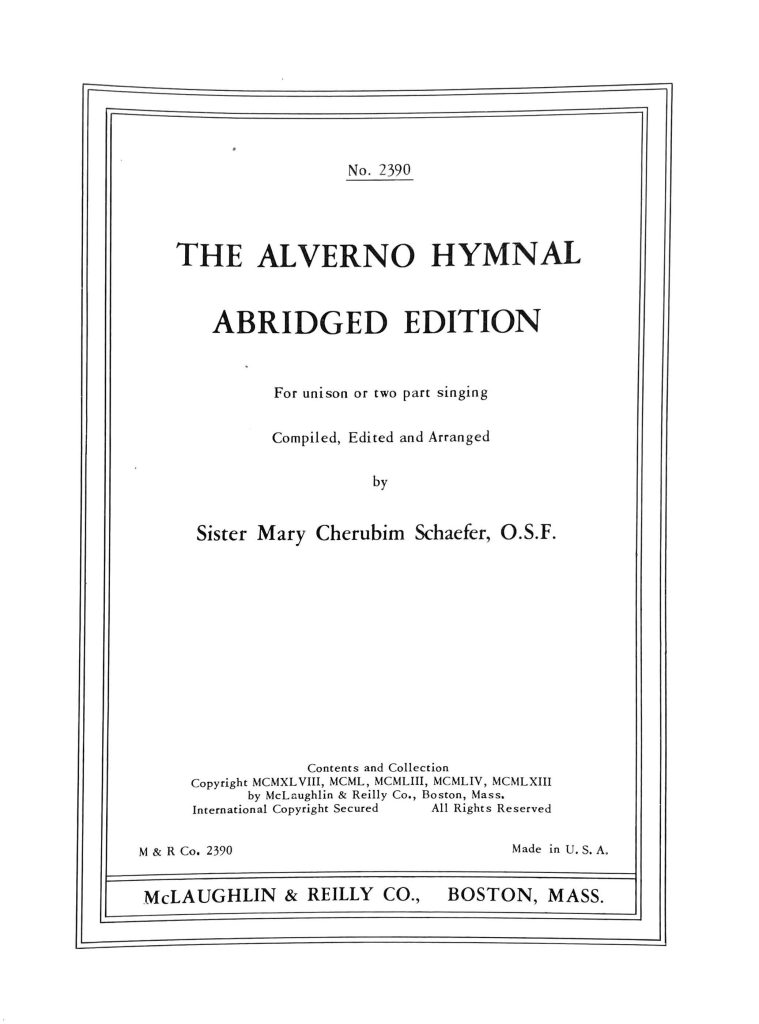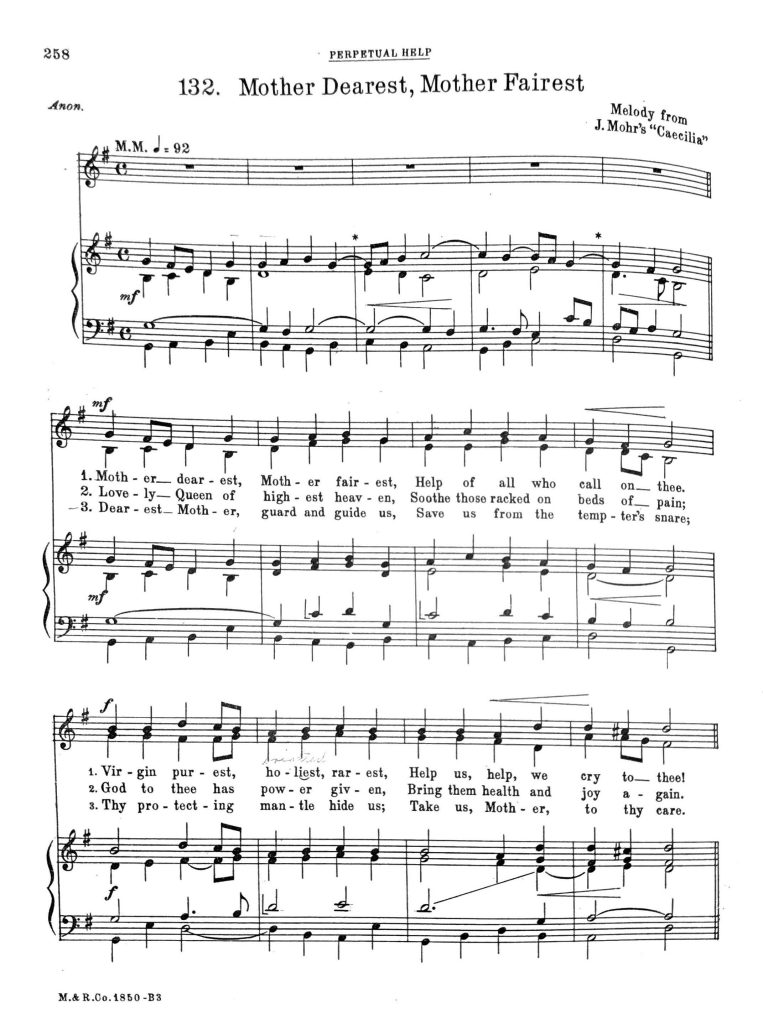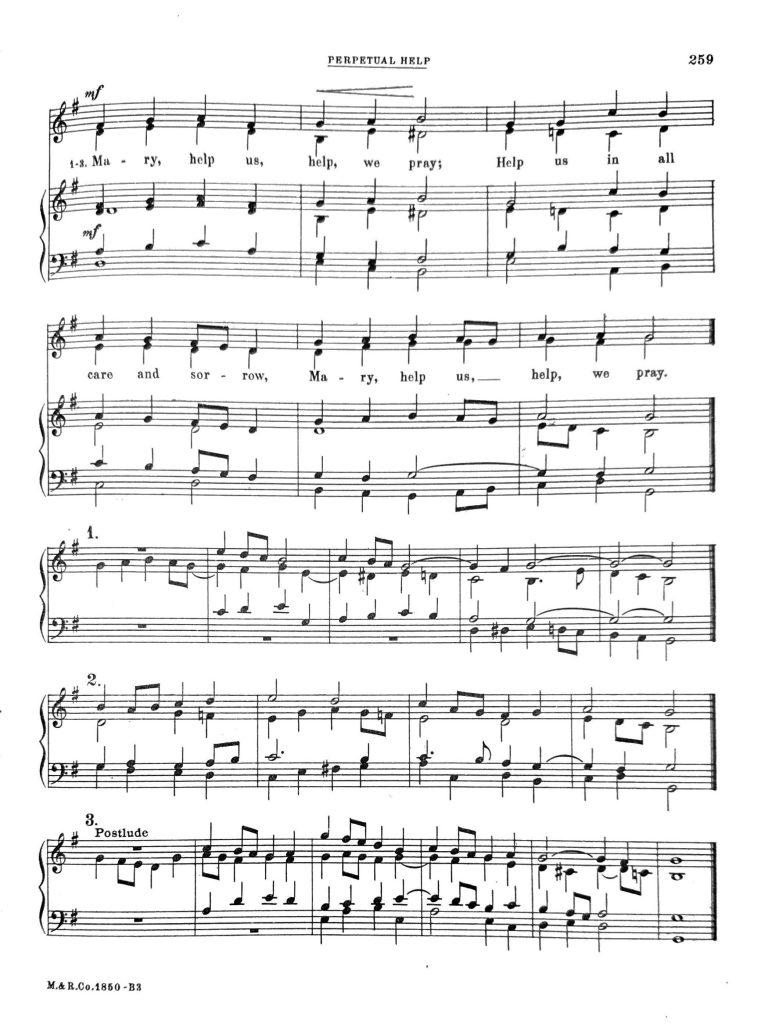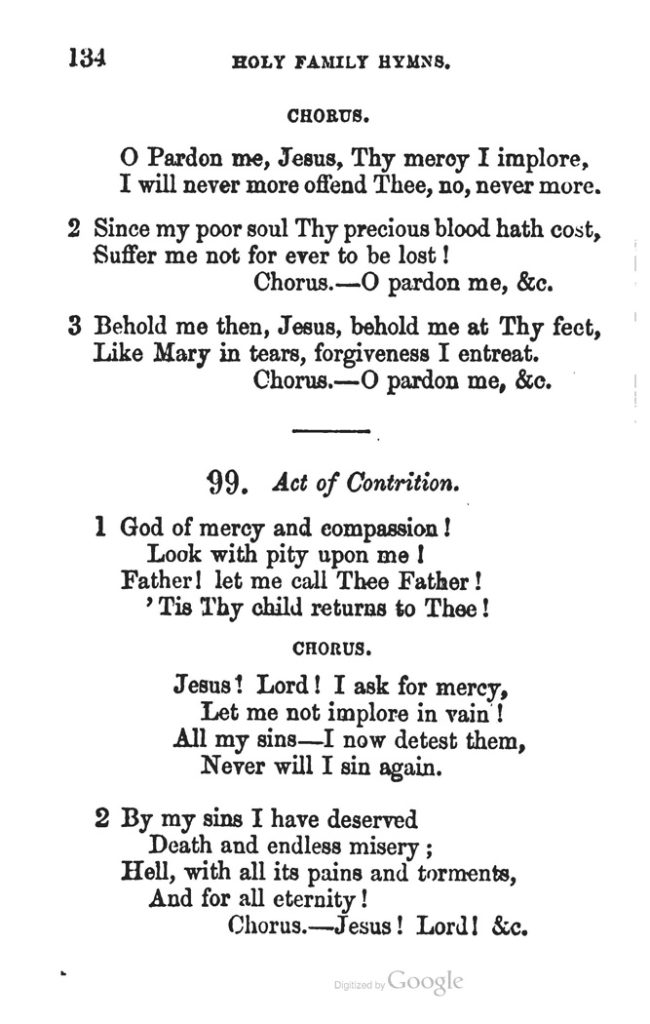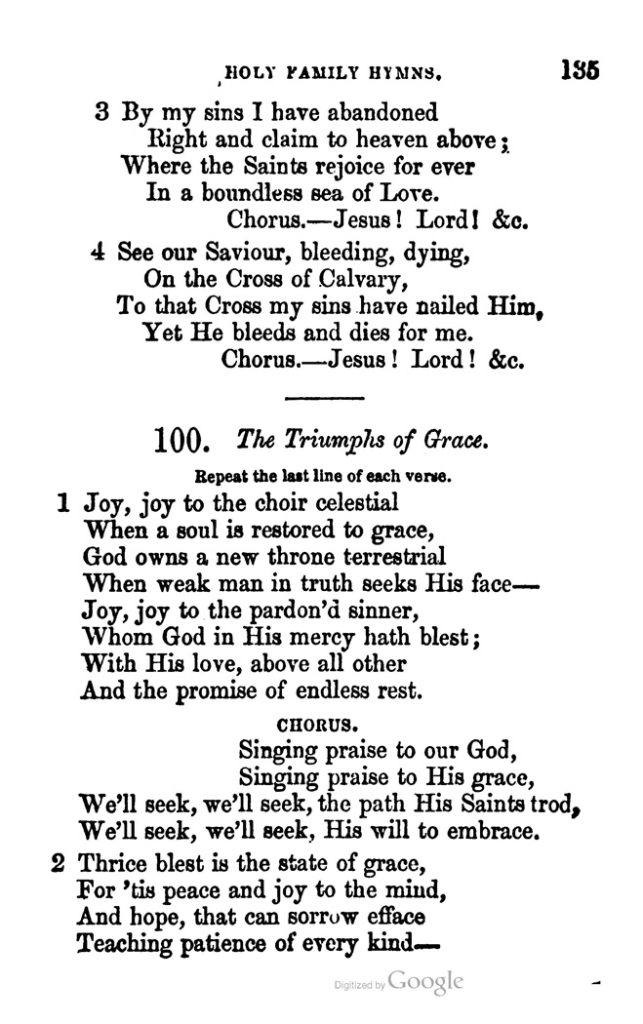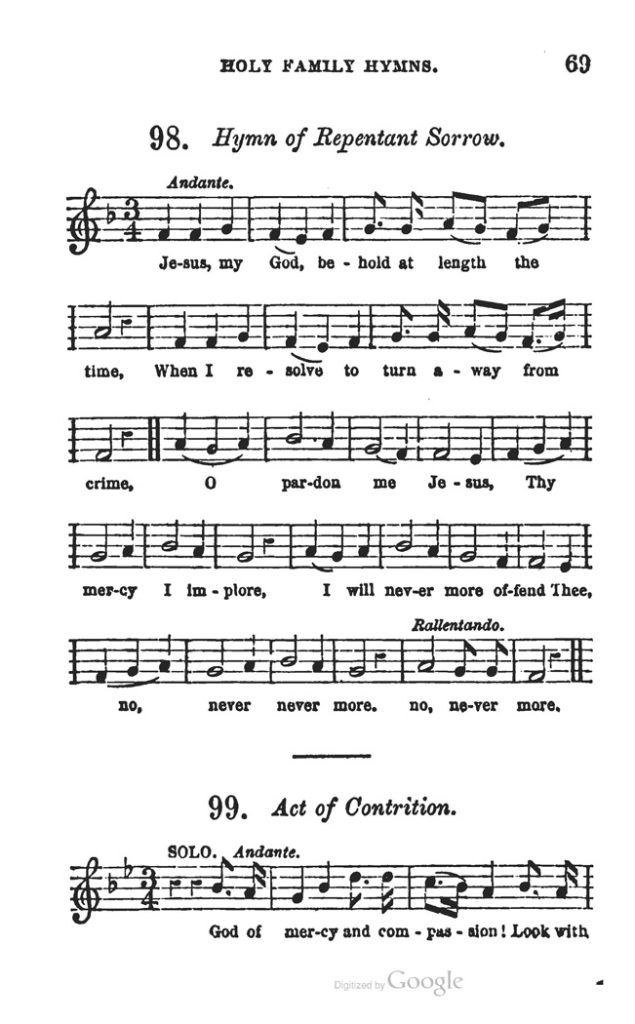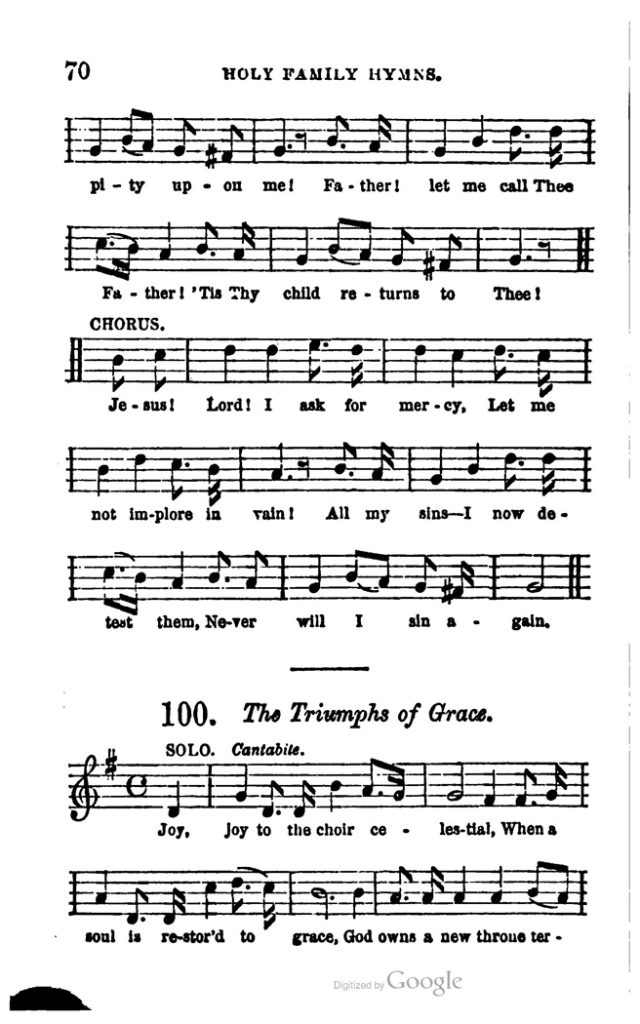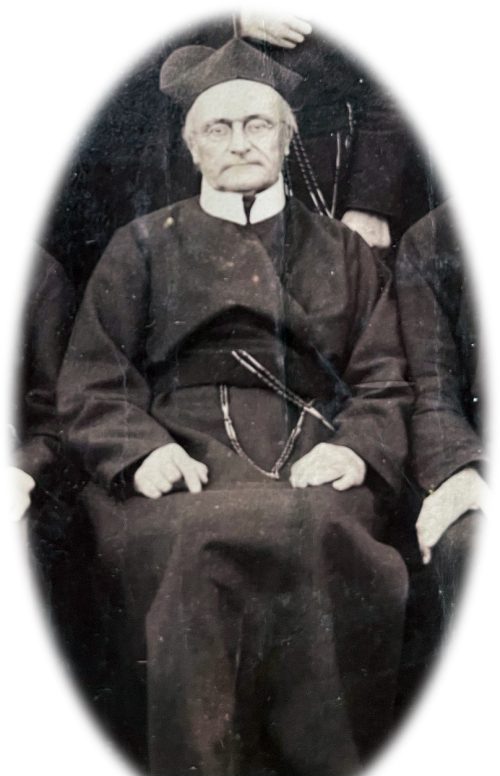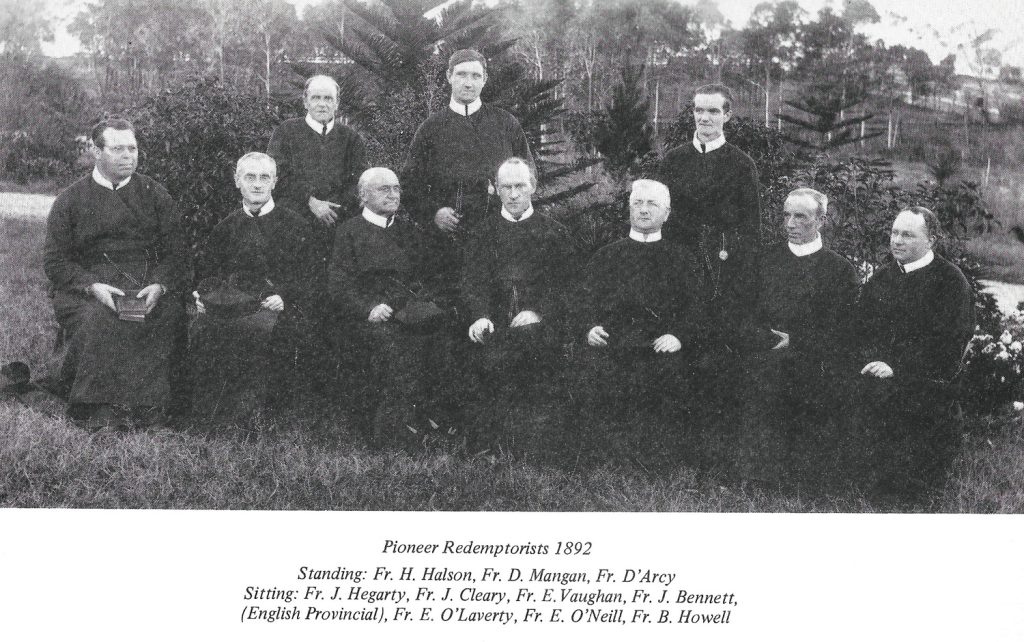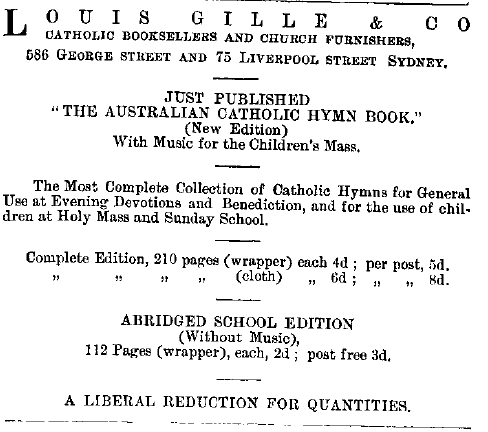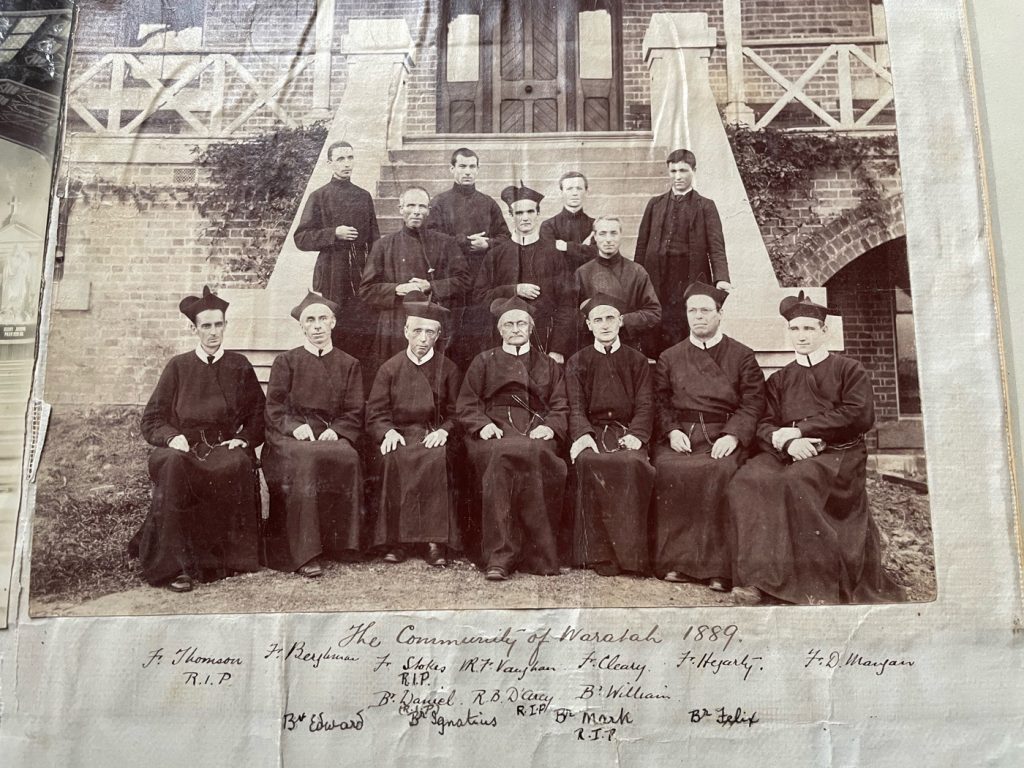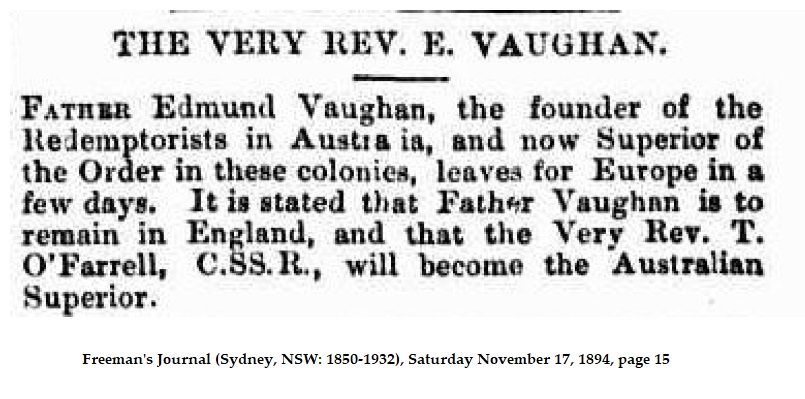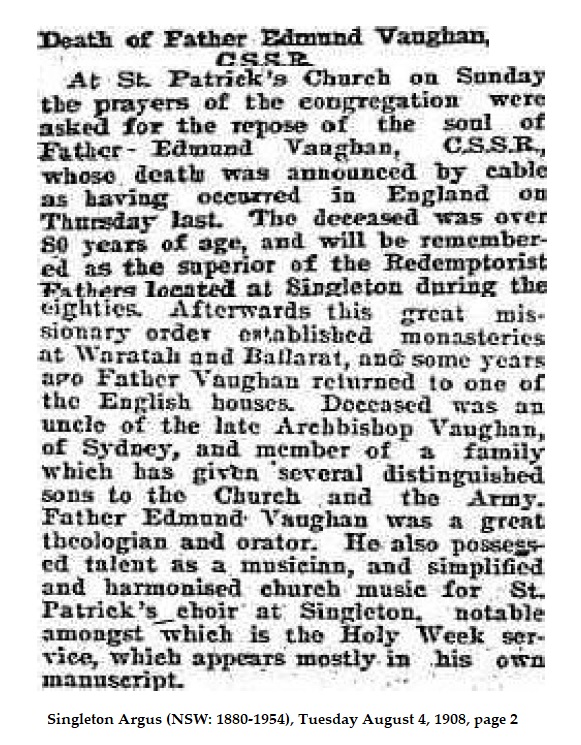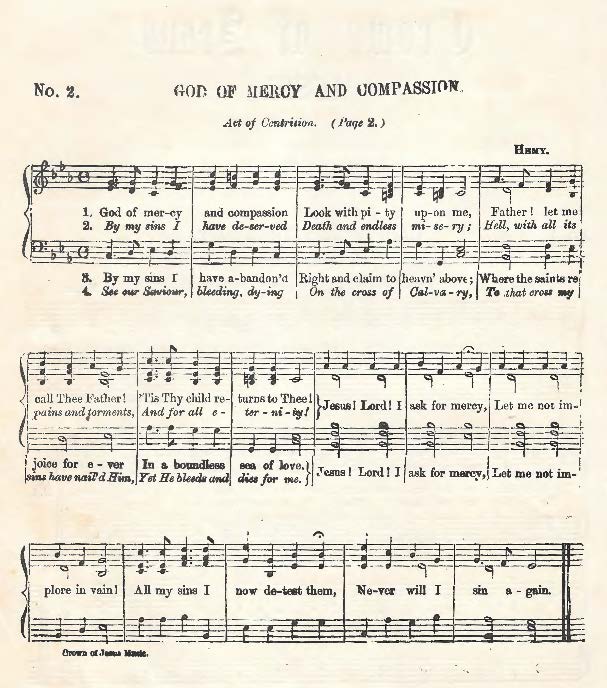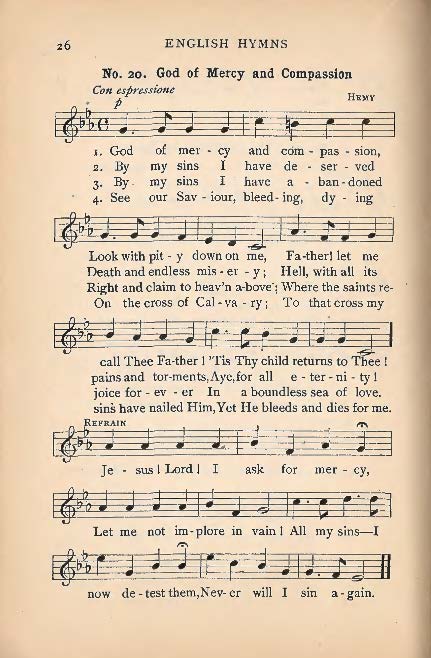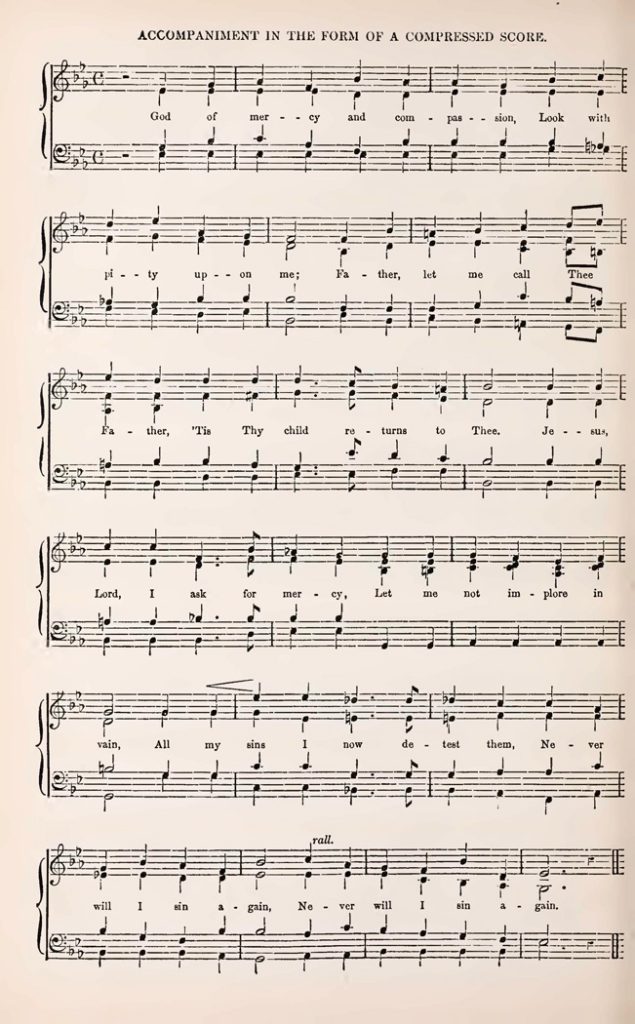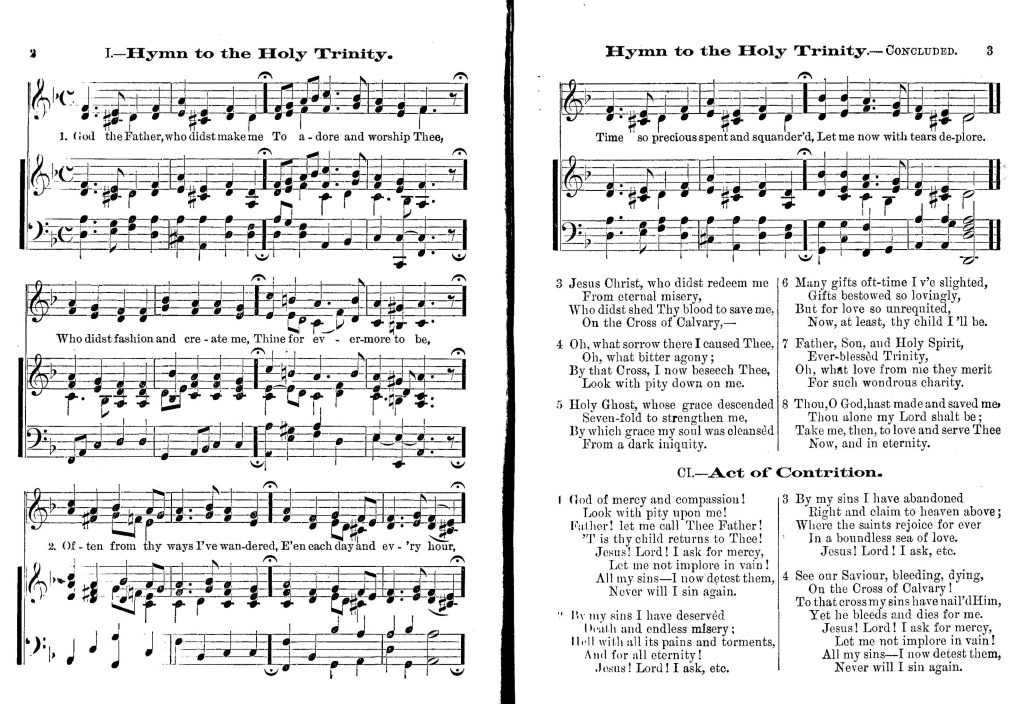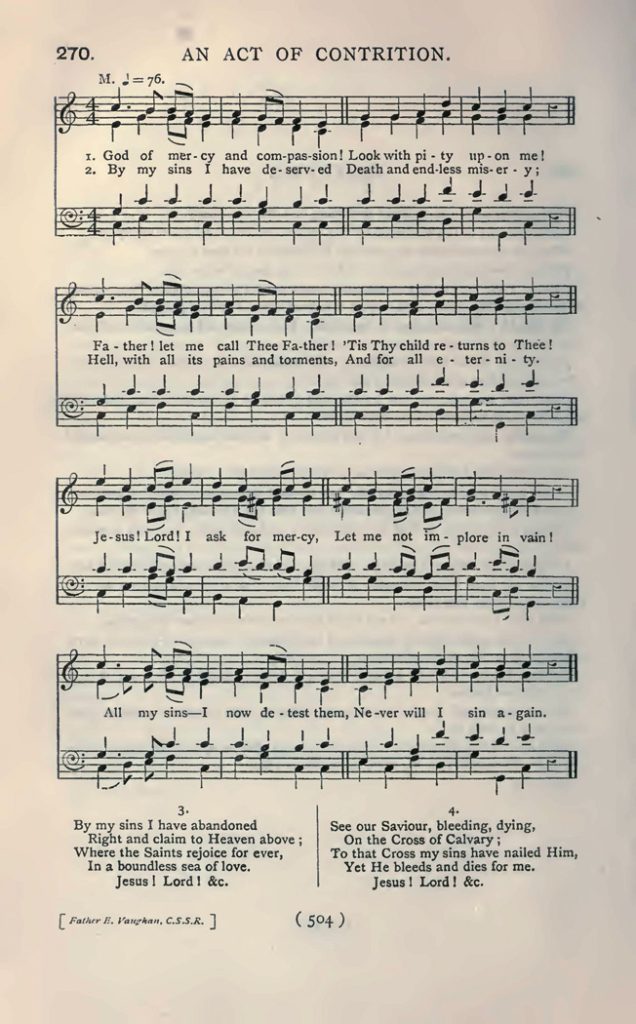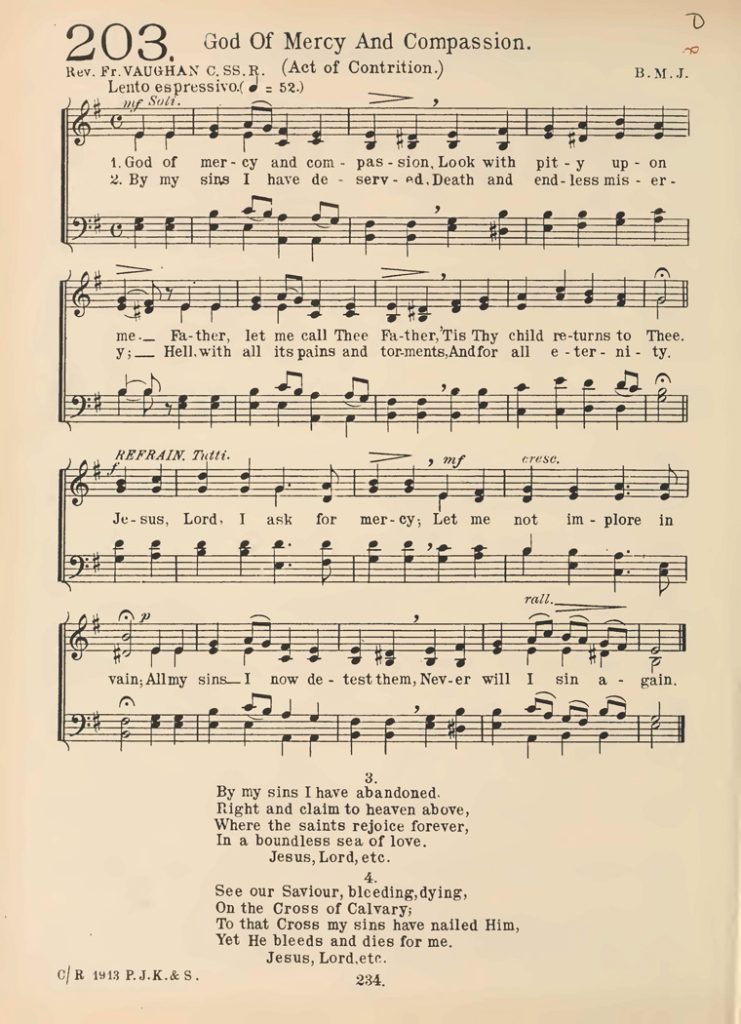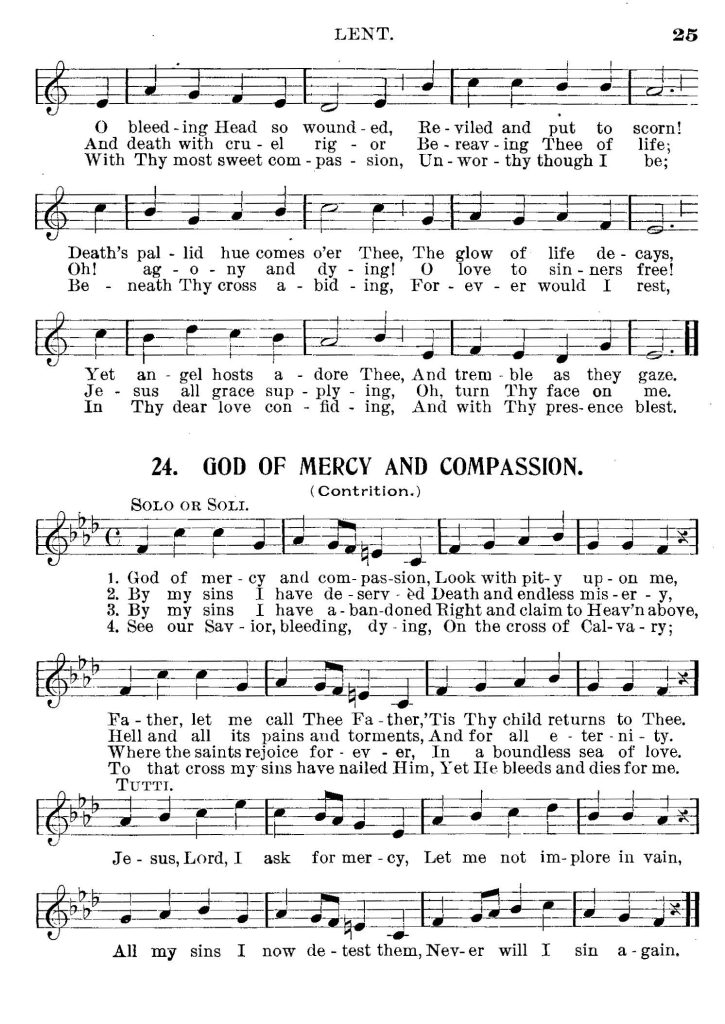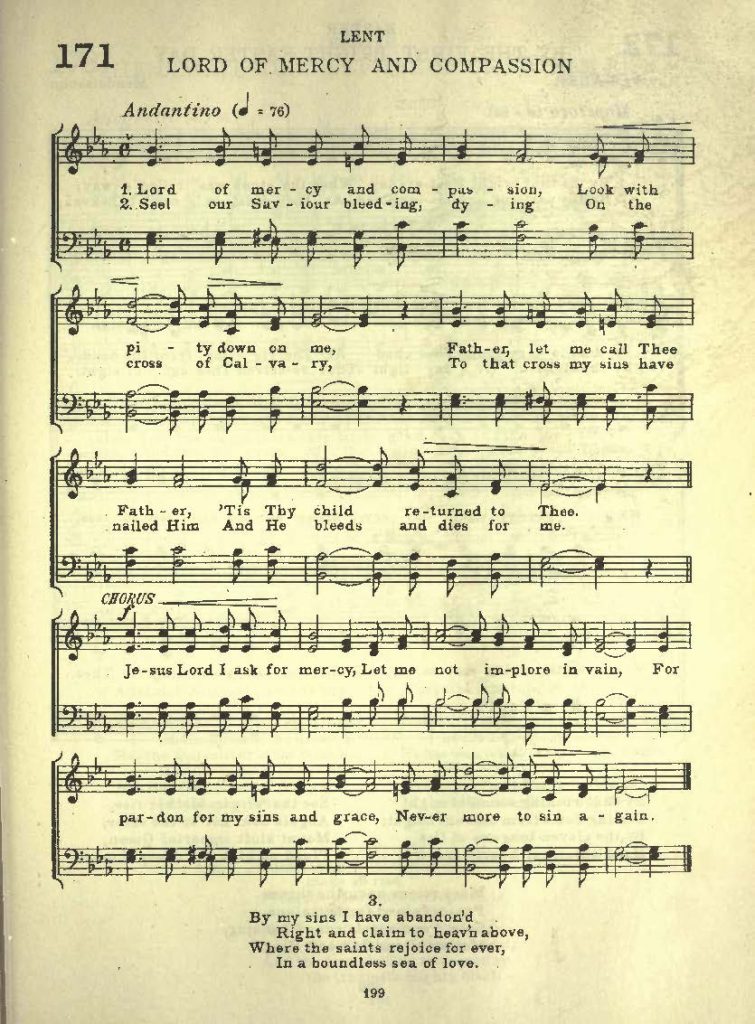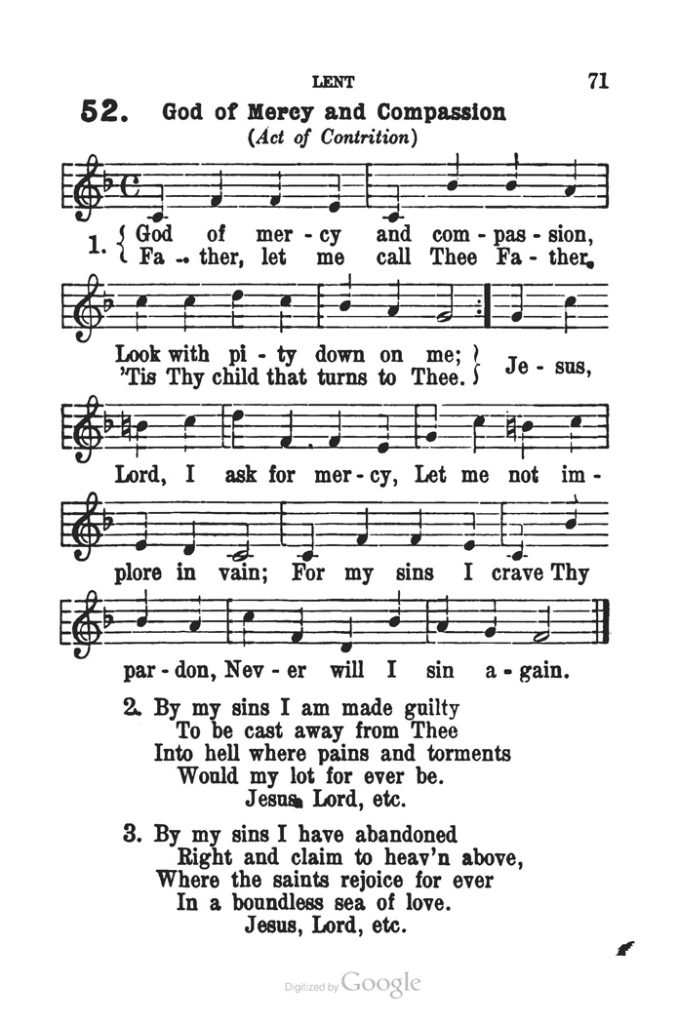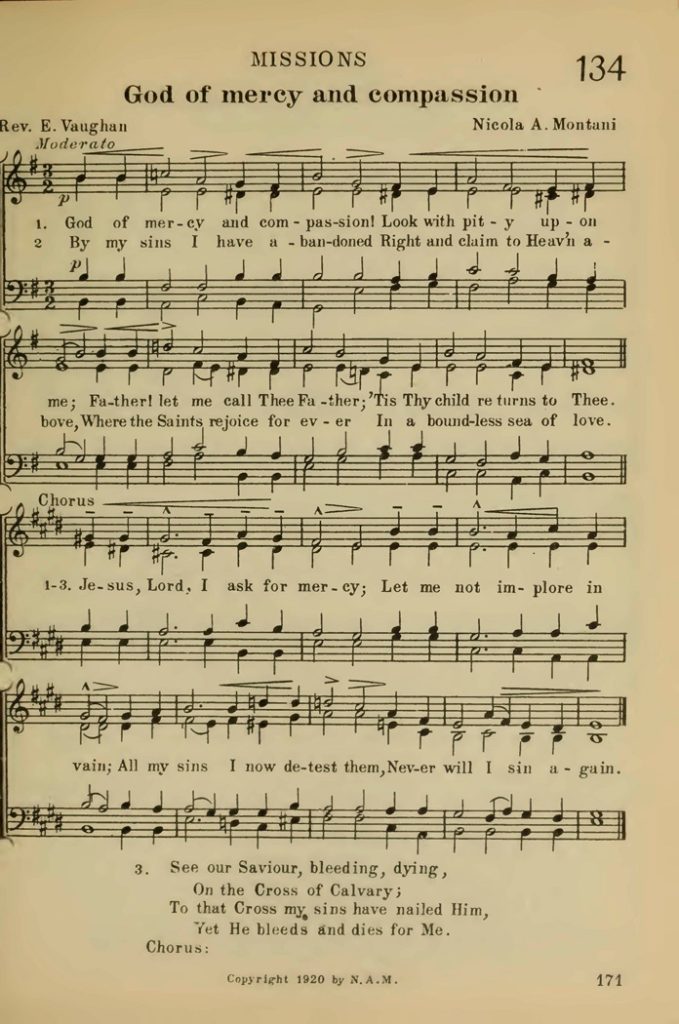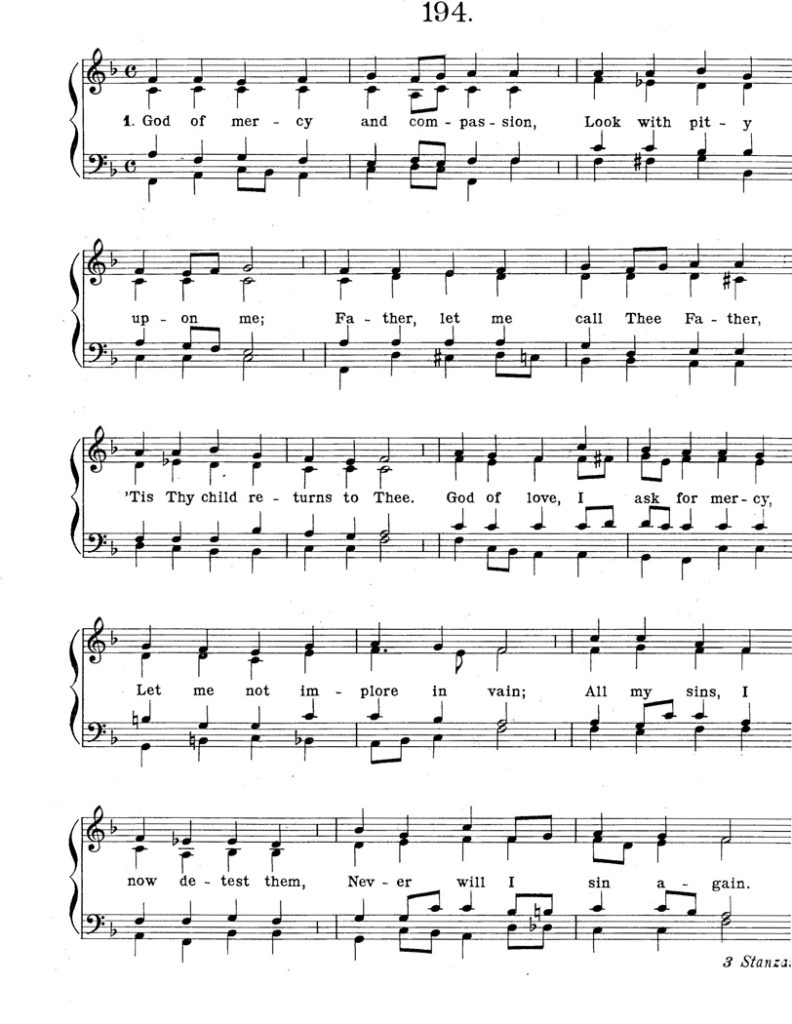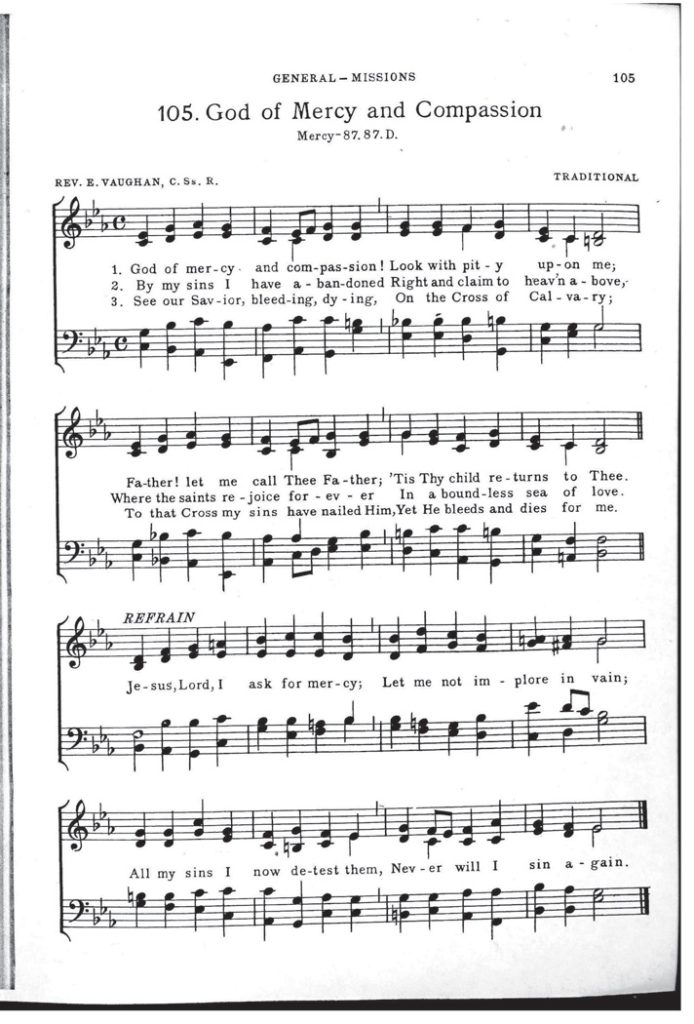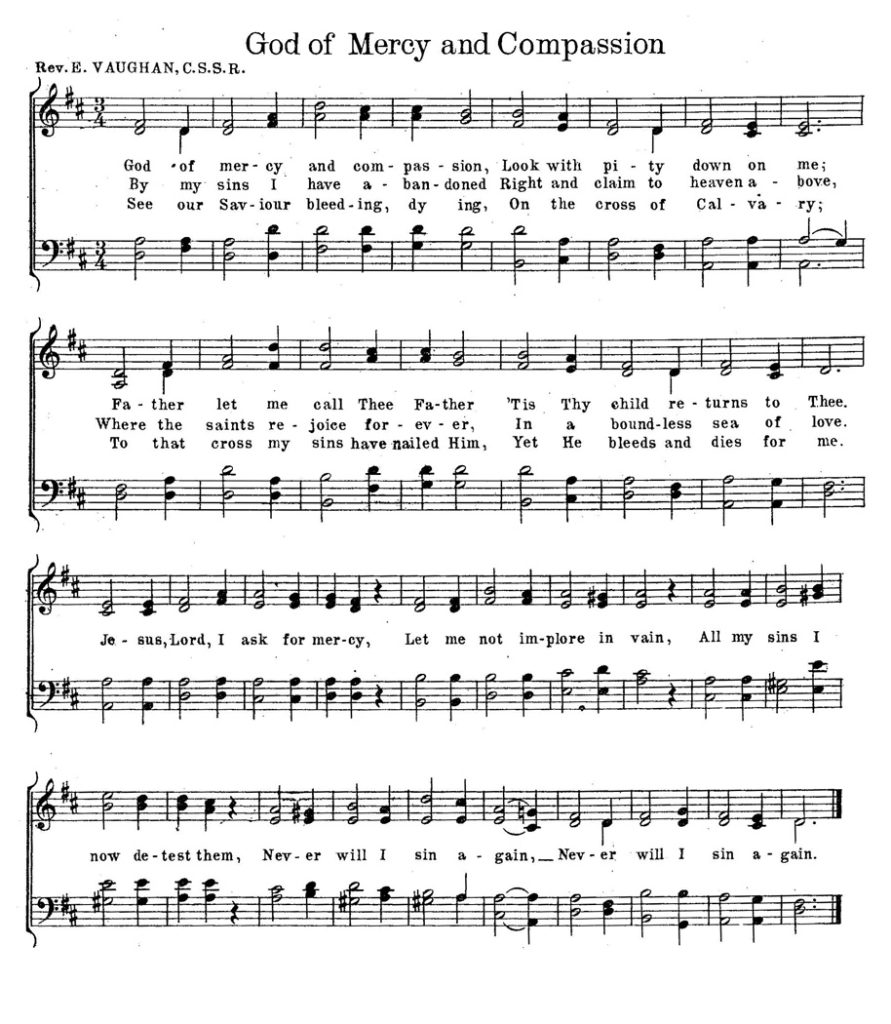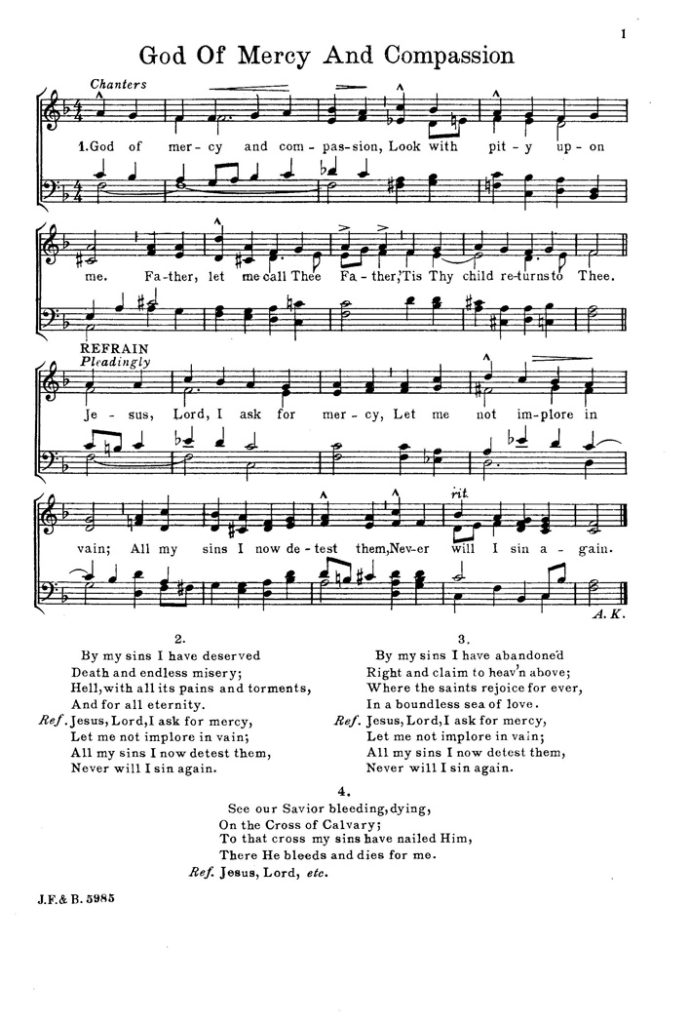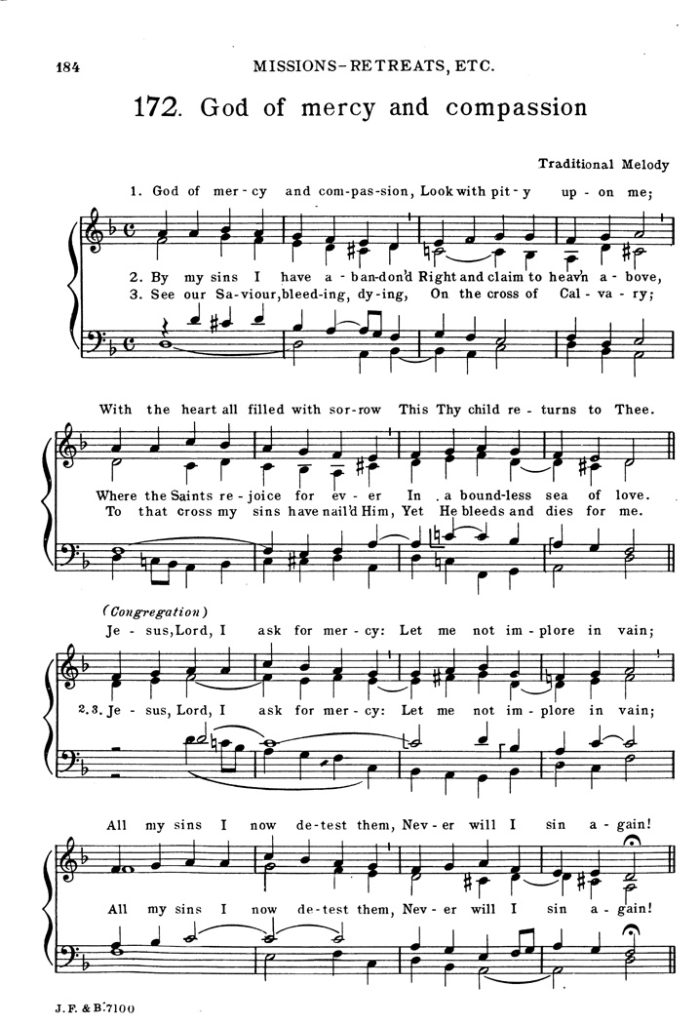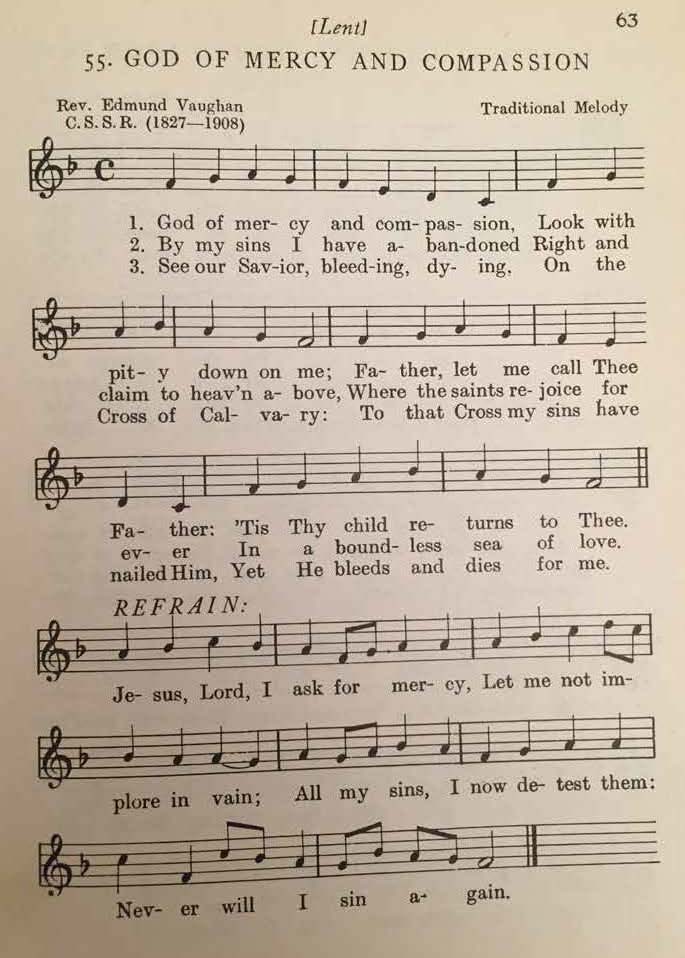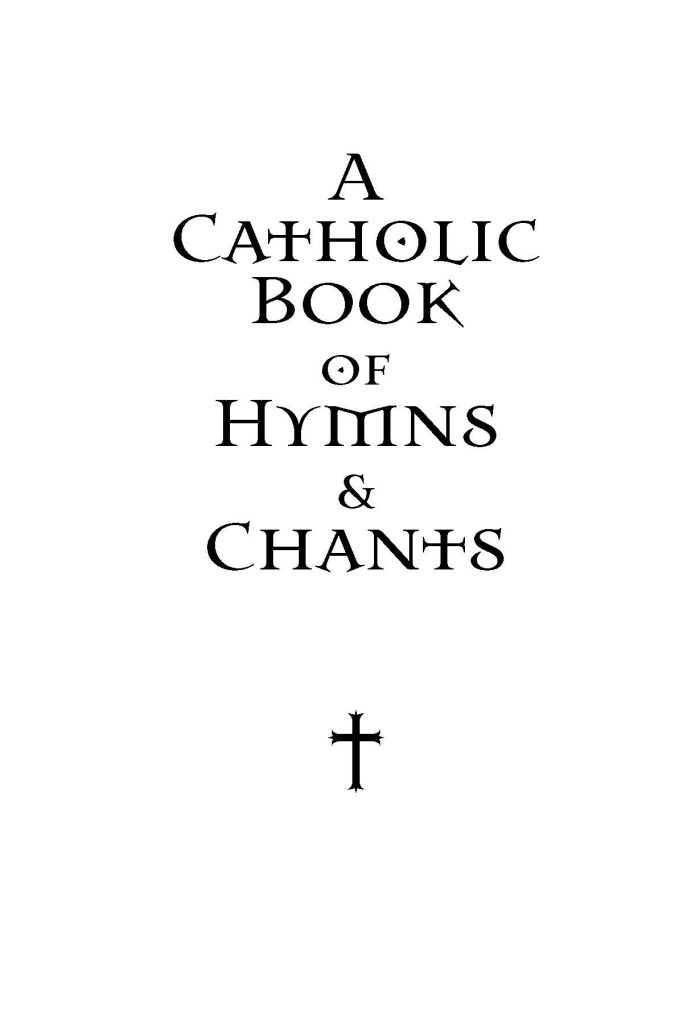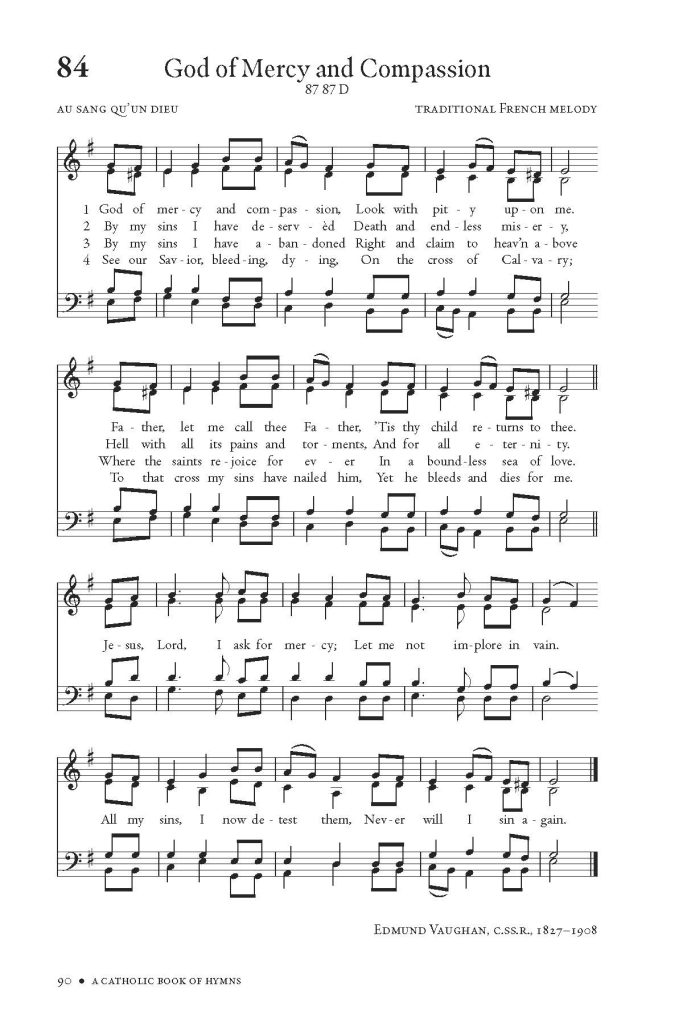Recently, the archivist for the School Sisters of St. Francis sent me a copy of the organ arrangment from the Alverno Hymnal Abridged Edition published by McLaughlin and Reilly Co., in 1963. This collection is the compilation of the three Alverno Hymnals published between 1948-1953. You can read about this wonderful Marian hymn the authors and composers by clicking on the following link: Mother Dearest, Mother Fairest
God of Mercy and Compassion
Father Edmund Vaughan, C.SS.R., wrote the words to this hymn, and it first appeared in the HYMNS FOR THE CONFRATERNITY OF THE HOLY FAMILY published by Burns & Lambert of London in 1854. This small and rare collection of Catholic hymns is currently not available. The next earliest appearance is in THE HOLY FAMILY HYMNS, captioned Act of Contrition, No. 99. This collection of hymns was published in 1860 London by Richardson and Son with the approval of Cardinal Wiseman (1805-1865). The hymn book contained both words and music. (Click on any image to enlarge)
It is beyond the scope of this short write-up to do a detailed biography of Father Vaughan. However, with the help of the Australian and English Provincials, the effort of a priest assigned to help, the work of Father Samuel J. Boland, C.SS.R., (1922-2011) who has written of the Redemptorists in Australia, I have put together the bits and pieces in order to present to you the following narrative on the life of Father Vaughan. Photographs were supplied courtesy of St. Mary’s Monastery, London, and those from Father Boland’s book Faith of our Fathers: The Redemptorists in Australia 1882-1982 with permission from the Australian Provincial. The only photographs of Father Vaughan that appear in this write-up are from his time in Australia.
Edmund Vaughan was born at Courtfield, Herefordshire, England in 1827, the son of William Vaughan and his wife Theresa. He was the youngest of nineteen children and while still a young boy, he suffered the loss of both parents. He was brought up in the family of his eldest brother who inherited the Vaughan estate of Courtfield, Herefordshire. Father Vaughan comes from an exceptional Catholic family noteworthy in producing vocations to the church.
One of his brothers, William became the Bishop of Plymouth, England; and two of his nephews would later become bishops, Herbert who became a Cardinal and Archbishop of Westminster, and Roger Bede, who became the second Archbishop of Sydney. Two of his three sisters became nuns. Father Vaughan was educated at Stonyhurst College, and was a science teacher for a few years at St Mary’s College, Oscott near Birmingham, before preparing for the priesthood. He was twenty-two and in deacon’s orders when he joined the Congregation of the Most Holy Redeemer, known as the Redemptorists, and spent a year of initiation at Saint-Trond near Liège, Belgium. In 1852, he took his religious vows and was ordained a priest becoming one of the first men from England to join the Redemptorists.
Among the early Redemptorists who knew Father Vaughan we have Father Robert Coffin, C.SS.R., (1819-1885) the first superior of the English Redemptorists. Father Thomas Edward Bridgett, C.SS.R., (1829-1899), a convert educated at Cambridge and became a gifted historian. Father John Furniss, C.SS.R., (1809-1865) who is best known for his gift of missions to children, and Father William Plunkett, C.SS.R., (1824-1900) who was the first Irish Redemptorist.
Father Vaughan was an exceptional orator, theologian, musician, and a teacher of science. He quickly devoted himself to missions following in the footsteps of St. Alphonsus Liguori who had founded the Order. Father Vaughan can be characterized as a man of great patience, understanding, and meticulous in details. His concern was not with crowds or criticism but the people. During the missions he had the people pray and he taught them to pray. He instructed them in the most essential truths of the Catholic faith, and in his sermons, he spoke plainly to the people without rhetoric or harshness. His aim was to restore in souls the practices and values of Catholic life. He was a man after the heart of St. Alphonsus Ligouri.
In time, and with experience in the missions, he was chosen to be superior of a foundation to be made in Scotland. In 1867, he established St. Mary’s Monastery in Perth, the first religious house to be established in Scotland since the days of King Henry VIII (1509-1547) and the Reformation.
It was during these early missions that Father Vaughan wrote hymns and he is recognized as the translator of the hymns of St. Alphonsus Ligouri. I have found twenty-two hymns written or translated by Father Vaughan with possibly more to be discovered. These hymns first appeared in English and American Catholic hymnals of the 1850s and 1860s.
During the early 1800s, Australia was for many in the world an unknown country slowly emerging from its convict days as a penal colony, and for those early pioneering Catholic clergy, traveling the great distances between the settlements made it nearly impossible to provide the pastoral care that was needed. Troubles for the Catholic Church in Australia were increasing too. The discovery of gold in the 1850s brought a rapid increase in more settlements, many of which were scattered to the remotest parts of the outback. Anti-Catholicism was on the rise, and the Education Acts of 1870s deprived Catholic schools of government aid. The isolation of settlements in the outback meant that for many Catholics there was no Mass, no Sacraments, or Catholic education for many years.
Between 1848 and 1867, Archbishop John Polding (1794-1877), Bishop James O’Quin (1819-1881), and Father Patrick Dunne (1818–1900) traveled to Europe and Ireland seeking Redemptorists foundations for Australia, and even though the Redemptorists had spread throughout Europe, the United States, and the West Indies, they were for the most part staffed by only a handful of priests. The possibility of such and undertaking for a land so far away and still virtually unknown was something the Superior General in Rome could not foresee happening anytime soon. Undaunted, the bishops continued to make several trips to Europe to appeal for help.
In 1880, Bishop James Murray (1828-1909) of Maitland was visiting and old friend in Ireland, Bishop Patrick Francis Moran (1830-1911) of Ossory who in a few short years would become Cardinal and Archbishop of Sydney. Bishop Murray had been in Ireland twelve years earlier when he observed the church filled with men twice each week for confraternity devotions. During this visit, he made a personal commitment to bring the Redemptorists back with him to Australia. From Ireland, Bishop Murray traveled to Rome with Bishop Moran when they met with Father Nicolas Mauron (1818-1893) the Superior General. They brought to his attention of the need for a foundation in Australia. This time, a consensus was reached, and the Superior General approvingly referred them to Father Coffin, who was the superior of the English Redemptorists. Bishop Murray satisfied that he now had approval returned home, for it was late in the year and his duties as bishop did not allow him to winter in Europe.
In 1881, Bishop Murray was back in England and wasted no time in approaching Father Coffin with a proposal that the Fathers take charge of a parish. Redemptorists often shy away from parish duties so that they can be free for missions, nevertheless, after some rather lengthy discussions and concessions it was agreed that the Fathers would take over a parish just for a time until a permanent monastery could be established. Bishop Murray made several parish suggestions but the one he felt would be most suitable was Singleton. Bishop Murray became a friend to the Redemptorists and was one of their most trusted advisers and supporters for as long as he lived.
Fathe Mauron, the Superior General was most agreeable to this new venture and in November of 1881 he called Father Coffin to Rome to discuss which Fathers would form the foundation in Australia. After careful consideration, Father Edmund Vaughan was chosen to be superior for the new foundation. Three other Redemptorists priests and two brothers were chosen to accompany Father Vaughan. They were Father Thomas O’Farrell (1898-1907), Father James Hegarty, Father Henry Halson, Brother Daniel Gleeson, and Brother Lawrence Watters.
The journey to Australia took several weeks, the pioneering group of Redemptorists left England on or about February 9 and traveled aboard the Orient steamer Sorata arriving in Sydney Harbor on March 31, 1882. The missioners brought with them a small picture of Our Lady of Perpetual Help that had been blessed by Pope Leo XIII. In this new land, the Fathers made the Mother of Perpetual Help their patron and her picture is found in Catholic churches throughout Australia and New Zealand.
When Father Vaughan arrived in Australia, he was already 54 years of age. The parish church in Singleton was small but adequate and nearby was a convent of the Sisters of Mercy with a school for girls. The presbytery or the home for the Fathers which had been built recently, was only large enough to accommodate two priest making living conditions somewhat challenging for the Fathers. The Fathers also quickly learned that the small parish entrusted to them was in debt, in need of repairs, and was serving as a school for boys during the week.
Within the first year of the Fathers arrival at Singleton and from some of their first meetings with the Australian Catholics, one thing stood out more than all the others. It was observed that there was a certain aridity in church services. It was determined that what was missing was music and singing. Father Vaughan set out to rectify the situation. He established a Society of St. Cecilia for the adults whose purpose it was to promote a reverent and beautiful celebration of the Liturgy. He also compiled the first Catholic hymn book in Australia which became THE AUSTRALIAN CATHOLIC HYMN BOOK with first edition published in 1884. The collection contained some of the most popular English hymns, a few of his own compositions, and a number of his beautiful translations from St. Alphonsus. For the children’s Masses, he taught them to sing the hymns of Father Furniss. The hymn book was published in both Australia and New Zealand until 1944.
Within the first five years the missions had expanded into New Zealand and in the summer of 1886 the Fathers crossed into Southern Australian. Also during the first five years the number of Fathers increased to include five additional priests and one brother. The house in Singleton, originally built for two priest was no longer a suitable home for so many. Land was purchased in Waratah, New South Whales just outside of New Castle and about fifty miles southeast of Singleton. A new home was erected and built at a place known as Harbottle Hill which Father Vaughan would later rename Mount St. Alphonsus. By 1887, the Fathers had moved from the small house in Singleton to their new home.
Father Vaughan remained in Australia for twelve years and was affectionately known to his companions as the grand old chief. He was recalled to England in 1894 and was appointed Provincial Superior of the Redemptorist houses of both England and Ireland. He died in 1908 after many years of faithful service.
There is so much more that could be written regarding the Redemptorists in Australia and of Father Vaughan’s role in those early pioneering days. I will revisit the Australian missions in future write-ups, so look for them in the months ahead. Much of what I have written could not have been possible without the work of Father Samuel J. Boland, which I mentioned at the beginning of this write-up. I found his book on the Redemptorists in Australia to be a wonderful source of spiritual nourishment and enlightenment during the first part of this 2024 Lenten season.
The Melodies
The hymn God of Mercy and Compassion has appeared in nearly fifty Catholic hymnals including those from America, England, Ireland, and Scotland. As of this writing, it is not known if the hymn appeared in the Australian Catholic Hymn Book. Rather than list the nearly fifty hymnals, I have provided a list that you can download. God of Mercy and Compassion – Hymnal Survey
In his Handbook for American Catholic Hymnals, J. Vincent Higginson (aka Cyr de Brant), identified six melodies which includes the traditional French melody Au Sang Qu’un Dieu. In addition to these six melodies, I have found ten more for a total of sixteen melodies. This is perhaps the greatest number of melodies for any one hymn that I know of or have written about.
Some of the melodies not listed by Mr. Higginson were composed or arranged by Nicola Montani; Sister Mary Alexis Donnelly, R.S.M.; Bishop Schrembs/Alfred Kalnins; a Marist Brother – Brother M. J. (B.M.J.) a pseudonym for Brother Zephiriny; Bernhard Molique; Henri F. Hemy, and several others yet to be identified.
The following section on the melodies is quite lengthy. I grouped them by time period (ex. 1860s, 1900s, etc.) and kept the details as brief as possible although there are a few exceptions. In a few instances, I only have melody editions of the hymnals and I cannot provide accompaniments. To facilitate an easier layout and for readability, I used pages from later period hymnals rather than the organ manuals. (Click on any of the images to enlarge)
The traditional French melody Au Sang Qu’un Dieu is from an opera by Giovanni Battista Pergolesi (1710-1736), he is credited with adapting/ harmonizing the tune for one of his operas. The melody appears to have been adopted quite early in Catholic hymnals as evidenced in the HOLY FAMILY HYMNS, 1860 shown at the beginning of this write-up. It is the most widely used melody appearing in a third of all the hymnals I surveyed for God of Mercy and Compassion.
During the 1860s and into the early 1900s three melodies appeared in Catholic hymnals. One of the melodies that appeared early on was composed by Henri F. Hemy (1818-1888) and appeared in his CROWN OF JESUS MUSIC. This collection was published in four parts but also as one volume in 1864. The melody also appeared in the CROWN HYMNAL compiled by Father Leslie J. Kavanagh who was the Superintendent of Catholic Schools of the Archdiocese of New Orleans and James M. McLaughlin who was the organist at St. Mary’s Church in Boston, Massachusetts. The hymnal was published in 1912 in both the United States and England. Father Kavanagh was elevated to Monsignor in 1919. The melody later appeared in the LAUDATE CHOIR MANUAL, 1942.
The second melody to appear in the 1860s was composed by Bernhard Molique (1802-1869) and is found in the POPULAR HYMN AND TUNE BOOK compiled by Frederick Westlake. This hymnal was published in 1868 London by Burns and Oates, and in New York by the Catholic Publication Society.
The third melody appeared in the American hymnal the CANTICA SACRA or Hymns for Children of Catholic Schools. The first edition of this hymnal was published in Boston in 1865 and was compiled by the Bishop of Boston, Rt. Rev. John B. Fitzpatrick (1812-1866). This collection contains hymns by Cummings, Faber, Caswall, and the translated hymns of St. Alphonsus Ligouri. A third edition was published in 1880. The music for this third tune appears to be a variation of traditional French melody and written for Hymn to the Holy Trinity.
Four melodies appeared in the early 1900s. The first is from the ARUNDEL HYMNS published in 1905. One of the editors was Henry, Duke of Norfolk who sent a copy of the hymn book to Pope Leo XIII for which he received a letter of approbation. The Arundel Hymnal was the first major English collection of the twentieth century. It is also one of the first hymnals to have author and composer details. This particular melody does not indicate a composer.
The second melody appears in the American Catholic Hymnal compiled by The Marist Brothers and published by J. P. Kennedy of New York in 1913 and later in 1921. Many of the hymns in this collection were taken from Catholic periodicals including the Messenger of Sacred Heart, Ave Maria, the Rosary Magazine, and others. Authors and composers are also various and include Miss Isabel Williams of Boston. She contributed several Holy Communion hymns which appear for the first time. There was also M. S. Pine, a pseudonym for a Sister of the Visitation – Sr. Mary Paulina Finn. Several of the melodies are by one of the Marist Brothers, B.M. or B.M.J., a pseudonym for Brother Zephiriny. He was the compiler and editor for the hymnal. Brother Zephiriny was one of the outstanding leaders in the U.S. province from 1892 until his death in 1928.
The third melody is found in the MANUAL OF CATHOLIC HYMNS for Schools, Choirs, and Congregational Singing. This collection of hymns and Mass settings which include funeral services, vespers, benediction services, and various litanies was compiled by Father Barnabas Dieringer (1863-1943), Professor of Music as St. Francis Seminary in Wisconsin and Father Joseph Pierron (1875-1945), pastor of St. Patrick’s Church, Lodi, Wisconsin. The hymnal was published by the Benziger Brothers of New York City with offices in Cincinnati and Chicago. The same melody appeared in the AVE MARIA HYMNAL published in 1936 and indicates the following source: Geisti. Lustwäldl, 1690.
The fourth melody appears in the ST. BASIL’S HYMNAL of 1906 published by the Basilian Fathers of Toronto, Canada. The composer for the melody is not given. There is also a significant number of text changes including the hymn title Lord of Mercy and Compassion. In the first verse we see look with pity down on me, and ‘Tis thy child returned to Thee. What is typically the fourth verse is now the second verse. In the chorus the phrase that normally reads All my sins – I now detest them, was changed to For pardon for my sins and grace. The hymn continued to appear in the St. Basil’s hymnal until 1918 and was removed in later editions. The same melody was used for another hymn found in the St. Basil’s hymnal, O Turn To Jesus, Mother, Turn a hymn written by Father Frederick Faber for the Holy Souls.
During the 1920s and 1930s, six melodies appeared in Catholic hymnals. The first is the CATHOLIC HYMNAL compiled by Father John G. Hacker, S. J., (1877-1946) of Canisius College, Buffalo, New York. It was published by Schwartz, Kirwin & Fauss of New York City in 1920. The melody used here is a German tune found in Tochter Sion, compiled by Dr. Heinrich Lindenborn (1712–1750) and published in 1741. The melody also appeared in the SURSUM CORDA, 1925.
The second melody was composed by Nicola Montani (1880-1948). This melody appeared in the ST. GREGORY HYMNAL AND CHOIR BOOK compiled by Nicola Montani and published by the St. Gregory Guild of Philadelphia in 1920. He was a conductor, composer, arranger, and publisher of sacred music.
The third melody appeared in the ST. MARY’S HYMNAL – Chants and Hymns compiled by Christian A. Zittel and published by the Catholic Book Publishing Co., of New York in 1924. This collection of hymns continued to be published until 1946. The melody is a German tune taken from Wilhelm Becker’s Gebet-und Gesangbüchlein of 1872.
A fourth melody is found in the PSALLITE hymnal compiled by Father Alexander Roesler, S.J., (1875-1904) with the first edition published in 1901. When Father Roesler died, Father Ludwig Bonvin, S.J., (1850-1930) became the editor, he altered various hymn texts, added some new tunes, and issued a revised collection as HOSANNA, 1910. The PSALLITE continued to be published as a separate collection until the twelfth edition in 1925. Father Bonvin was a teacher at Canisius College in Buffalo, New York, and is credited with 450 separate compositions including Masses, chorals, hymns, and one symphony. His musical talents were an important contribution to the Catholic Church worldwide. The same melody reappeared in the MEDIATOR DEI hymnal in 1955 that was compiled by Cyr de Brant, a pseudonym for J. Vincent Higginson.
A fifth melody was composed by Sister Mary Alexis Donnelly, R.S.M. (1857-1936), from the Providence, R. I., community. Her name and contributions have been forgotten in the history of Catholic musicians. She was a close friend of James A. Reilly, president of the Catholic Music Publishing Company, later McLaughlin & Reilly Company, one of the major publishers and distributor of Catholic music in America. She compiled three hymnals, THE HOLY FACE HYMNAL in 1891, OUR LADY OF MERCY HYMNAL in 1899, and OUR LADY OF MERCY HYMNAL VOL. II., in 1927. Many of her compositions were featured in a series of hymn pamphlets which proved to be an enormous success for McLaughlin & Reilly and were sold continually during the company’s existence.
A sixth melody was composed by Bishop Joseph Schrembs of Cleveland, Ohio and harmonized by Alfred Kalnins. Bishop Schrembs compiled and published three hymnals including, THE DIOCESAN HYMNAL PART 1 which was published in 1926 consisting of Communion and Confirmation Hymns. THE DIOCESAN HYMNAL PART 2 consisting of Devotional Hymns, and a third, THE EUCHARISTIC HYMNAL published in 1935, which embodied hymns taken from Part 1 & Part 2.
He was elevated to the office of Archbishop in 1935 and was the Promoter of the Seventh National Eucharistic Congress and Protector of the Priests’ Eucharistic League in the United States. He was himself a musician and composed several hymns and was instrumental in producing manuals of Gregorian Chant and Catholic editions of music text books for elementary schools. He is also considered one of the pioneers of Catholic radio. He spoke frequently on local radio stations giving sermons and catechetical instructions often followed by the singing of hymns for which he composed the tunes. He was instrumental in persuading the National Council of Catholic Men (NCCM) to sponsor the Catholic Hour that began broadcasting in 1930. This weekly radio program reached a large national audience.
In the 1950s, two melodies appeared. The first is found in the PAROCHIAL HYMNAL compiled by Father Carlo Rossini (1890-1975) and published by J. Fischer & Bro., of New York in 1936 and 1951. The second melody was composed by Louis Bourgeois (1510-1561) and appears in CATHOLIC HYMNS compiled by Father John C. Selner (1904-1992) and published by the Gregorian Institute of America in 1954.
Reflection
When I meditate on the verses, I see a personal plea to God from a sinful soul for mercy and compassion. Father Vaughan must have written this hymn as a teaching aid for the Catholics he encountered in his missions, teaching them to recognize that through sin, they have forfeited all rights and claim of heaven where the saints rejoice forever.
I can also see an allusion to the parable of the Prodigal Son (Luke 15:11–32) in the phrase, Father, let me call Thee Father: ‘Tis thy child returns to Thee. The penitent soul, realizing that their sins have nailed Him to the cross, Yet He bleeds and dies for me, encourages the soul to ask for mercy, detesting all their sins, never to sin again. The verses remind me of the Act of Contrition that we all say in confession after the good priest gives us absolution.
This hymn was written for Missions, Lent, and Passiontide, but it could be used throughout the year. We all need to be reminded to ask for God’s mercy and compassion. Take a moment to reflect on these verses and I am sure you will find some phrase that fits your situation. Each person who reflects on these verses will see something different or nothing at all. What can you see?
A special thank you to Peter Meggison producer of the Devotional Hymns Project for allowing me to link to recordings of the Schola Cantorum of the Cardinal Vaughan Memorial School in London which recorded the traditional French melody and the Chorus of Bridgewater State University, Bridgewater, Massachusetts who recorded the melody composed by Sister Mary Alexis Donnelly, R.S.M.
Also, to Noel Jones, AAGO in granting permission to link to A Catholic Book of Hymns and Chants with nearly three hundred time-honored traditional Catholic hymns, including God of Mercy and Compassion. You can download A Catholic Book of Hymns & Chants FREE at www.sacredmusiclibrary.com
A Catholic Book of Hymns and Chants now has a Facebook User Group offering advice and encouragement on adopting this hymnal and exploring the editions that match up with your parish needs. So be sure to visit and see how this wonderful hymn book is being used by fellow musicians.
Below are computer generated sound files of the melodies discussed in this write-up. The tempo is approximate but should provide the listener with a good sense of what the hymn sounds like.
00:00

